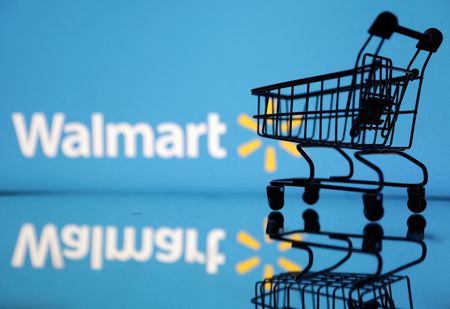By Katherine Masters
NEW YORK (Reuters) – Stocking shelves with low-priced notebooks and slashing prices on sneakers and uniforms, major retailers including Walmart, Foot Locker and Marks & Spencer are preparing for a challenging back-to-school shopping season this year.
U.S. shoppers’ spending in the summer ahead of the college and K-12 school year has grown steadily since 2015, according to the National Retail Federation, a trade group. NRF hasn’t yet issued an estimate for 2023.
Although shoppers have been spending on essentials this year, they’re much choosier on where to splurge as inflation remains stubbornly high, executives from Ulta, Macy’s, Ralph Lauren and Nordstrom said during earnings results over the last two weeks.
On Friday, Doug McMillon, CEO of Walmart, the world’s biggest retailer by sales, said at its annual meeting that it would roll out more back-to-school merchandise – notebooks, pencils, pens – at “opening price points” this year. Walmart CFO John David Rainey told investors last week that the retailer, while not immune to “economic whims,” is better positioned than others thanks to its reputation for low prices.
Clothing and sneakers previously made up the biggest chunk of back-to-school-related expenses for many families, and Foot Locker said on May 19 that it would rely on promotional discounts to drive demand for sneakers. The chain is stocking Adidas’ Samba and Gazelle sneakers ahead of the new school year, it said.
In Britain, where consumers are facing the biggest two-year squeeze in living standards since comparable records started in the 1950s, Marks & Spencer is holding the prices on its school uniform range for a third straight year. Prices start at 7 pounds ($8.69) for a multipack of three cotton unisex polo shirts. M&S is also offering an additional 20% off school uniforms for early shoppers.
The challenge for retailers is predicting whether parents will buy less clothing and sneakers when the cost of necessities – such as pencils, notebooks and laptops – strains many households. Purchases of discretionary goods such as clothing and shoes have fallen since January, according to U.S. Commerce Department data.
Retailers face a “volatile time,” said Jessica Ramirez, a senior research analyst at Jane Hali & Associates.
Ratings agency Moody’s in late May predicted “nascent and uneven” operating profit growth overall for global retail and apparel companies this year, with a 6.2% jump in North America-based operating profit following last year’s 13% decline.
Target recently lowered its full-year outlook on the back of a gloomy spending environment, pointing to cautious consumers who are prioritizing essentials over discretionary purchases like clothing and electronics.
Big-box retailers including Walmart and Target are poised to benefit from falling production costs thanks to their ability to renegotiate costs with suppliers, Moody’s said in a report.
Off-price stores such as T.J. Maxx are also likely to benefit from the sharp increase in consumers looking for savings, while dollar stores will be hurt by a shortage of disposable income among their core low-income customer base, according to Moody’s
Victoria’s Secret’s CEO Martin Waters said it plans a “complete overhaul” of its struggling PINK clothing brand, phasing out logo-emblazoned hoodies, tee-shirts and bottoms. Victoria’s Secret and department store chain Macy’s – which is also planning promotions to liquidate unsold inventory – pointed to pressure on consumers making between $100,000 and $150,000 a year and below.
Executives at Abercrombie & Fitch, American Eagle, Urban Outfitters and Kohl’s all said in earnings calls they were focusing on new styles – especially in activewear, dresses and non-denim bottoms – as a way to get parents to open their wallets.
Abercrombie & Fitch CEO Fran Horowitz said cargo pants, dressed-up denim that can be worn to the office and tailored trousers had all performed well for the millennial-focused Abercrombie brand. The mall retailer is in the process of adding similar styles in teen-focused Hollister stores, where sales fell 7% in the first quarter that ended April 29, ahead of the back-to-school shopping season.
Young shoppers often have less disposable income. Hedging its bets, American Eagle, which traditionally caters to teens, launched a new line of premium denim, including $128 jeans, that would also “entertain an older customer,” Executive Creative Director Jennifer Foyle said during an earnings call in May.
Even chains that grew overall sales reported recent losses among brands catering to teens. Those included Abercrombie’s Hollister brand and Urban Outfitters, whose parent company, URBN, reported strong first-quarter growth at its Anthropologie and Free People brands. URBN said the macroeconomic environment was having a greater impact on its younger consumers.
(Reporting by Katherine Masters in New York, Siddharth Cavale in Bentonville, Arkansas, and James Davey in London. Editing by Gerry Doyle)





